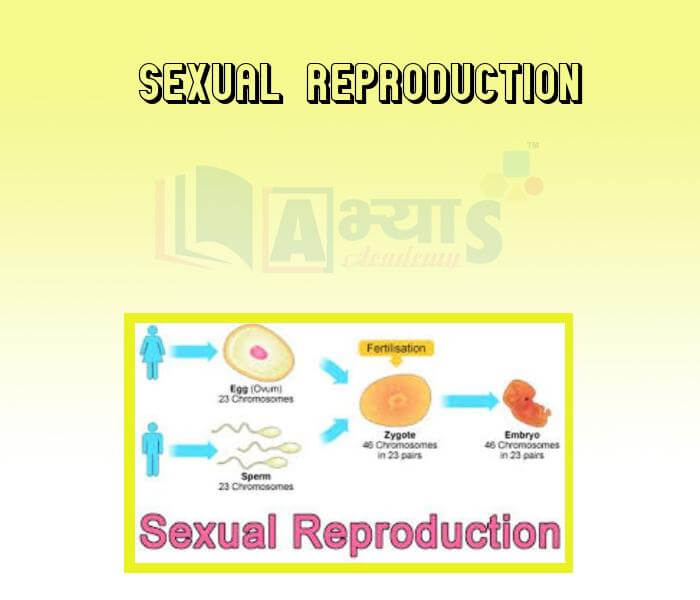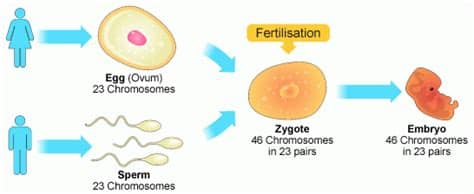Sexual Reproduction


Sexual Reproduction
Sexual reproduction involves the two sexes, namely, male and female. The male sexual unit is known as male gamete or sperm, while the female sexual unit is known as female gamete or egg. The formation of gametes and their fusion constitute sexual reproduction. The male gamete is smaller and more active than the female gamete. The female gamete is larger, filled with reserve food and remains passive. The cell formed after the fusion of the male and female gametes is called zygote. The zygote divides repeatedly to form a new individual. Although sexual reproduction also occurs in unicellular organisms like algae and Paramoecium, it is most common in multicellular organisms.

Genetic basis and advantage of variations: You know that variations help in the survival of a species over time. During asexual reproduction cells divide and DNA replication takes place. At the time of replication, some variation may occur but this variation does not usually cause any drastic change. So, in asexual reproduction offspring are more or less similar to the parent and variation is slow. During sexual reproduction two types of gametes (male and female) are formed. During the fusion of gametes there is recombination of genetic material from two parents. This leads to greater variation in the offspring. As the offspring gets more variations, it is more likely to adjust better to environmental fluctuations.
Gametes contain half the usual number of chromosomes: During sexual reproduction, the combination of DNA from two parents would result in the offspring having twice the amount of DNA. To solve this problem, sexually reproducing individuals have special germ cells (gametes) with only half the normal number of chromosomes and, therefore, half the amount of DNA compared to the other cells of the body. When such germ cells from two individuals unite during sexual reproduction, the normal chromosome number and DNA content are restored.
Significance of sexual reproduction: Sexual reproduction results in new combinations of genes that are brought together during gamete formation. This reshuffling of genes in the gametes increases the chances of variation in the offspring. Moreover, the combination of two sets of chromosomes, one set from each parent, during zygote formation, leads to variation within a species.

Sexual Reproduction : - This mode of reproduction involves the union of male and female. The fusion of gametes result in the formation of zygote fro which the new individual develops. This process is termed as fertilisation. So fertilisation is the fusion of the nuclei of male and female gamete to form a zygote from which a new individual can develop.
In animals, the male and female gametes are generally produced in separate individuals. The male gamete is called the sperm and is produced in the testes. The female gamete is called the ovum or egg and is produced in the ovaries. In certain animals like the tapeworm both sex organs (testes and ovary) are present in a single individual.
In plants, the sexes may or may not be separated. Accordingly, a flower is either unisexual (bearing either male or female game or bisexual (bearing both gametes).
Characteristics of sexual reproduction
If both ovaries are removed from a rat, then which hormone is decreased in the blood ____________________________ | |||
| Right Option : B | |||
| View Explanation | |||
Sometimes, larvae develop gonads and reproduce by normal sexual reproduction. It is called ____________________ | |||
| Right Option : B | |||
| View Explanation | |||
Offspring formed as a result of sexual reproduction exhibit more variations because : | |||
| Right Option : B | |||
| View Explanation | |||
Students / Parents Reviews [20]
When I have not joined Abhyas Academy, my skills of solving maths problems were not clear. But, after joining it, my skills have been developed and my concepts of science and SST are very well. I also came to know about other subjects such as vedic maths and reasoning.

Sharandeep Singh
7thThird consective year,my ward is in Abhyas with nice experience of admin and transport support.Educational standard of the institute recumbent at satisfactory level. One thing would live to bring in notice that last year study books was distributed after half of the session was over,though study ...

Ayan Ghosh
8thMy experience with Abhyas academy is very nice or it can be said wonderful. I have been studying here from seven class. I have been completing my journey of three years. I am tinking that I should join Abhyas Academy in tenth class as I am seeing much improvement in Maths and English

Hridey Preet
9thWe started with lot of hope that Abhyas will help in better understnding of complex topics of highers classes. we are not disappointed with the progress our child has made after attending Abhyas. Though need to mention that we expected a lot more. On a scale of 1-10, we would give may be 7.

Manya
8thMy experience with Abhyas Academy has been very good. When I was not in Abhyas whenever teacher ask questions I could not speak it confidently but when I came in Abhyas, my speaking skills developed and now I am the first one to give the answer of teachers question.

Upmanyu Sharma
7thAbhyas is an institute of high repute. Yogansh has taken admission last year. It creates abilities in child to prepare for competitive exams. Students are motivated by living prizes on basis of performance in Abhyas exams. He is satisfied with institute.

Yogansh Nyasi
7thOne of the best institutes to develope a child interest in studies.Provides SST and English knowledge also unlike other institutes. Teachers are co operative and friendly online tests andPPT develope practical knowledge also.

Aman Kumar Shrivastava
10thAbhyas institute is one of the best coaching institute in the vicinity of Ambala cantt.The institute provides good and quality education to the students.The teachers are well experienced and are very helpful in solving the problems. The major advantages of the institute is extra classes for weak...

Shreya Shrivastava
8thThe experience was nice. I studied here for three years and saw a tremendous change in myself. I started liking subjects like English and SST which earlier I ran from. Extra knowledge gave me confidence to overcome competitive exams. One of the best institutes for secondary education.

Aman Kumar Shrivastava
10thI have spent a wonderful time in Abhyas academy. It has made my reasoning more apt, English more stronger and Maths an interesting subject for me. It has given me a habbit of self studying

Yatharthi Sharma
10thAbhyas is good institution and a innovative institute also. It is a good platform of beginners.Due to Abhyas,he has got knoweledge about reasoning and confidence.My son has improved his vocabulary because of Abhyas.Teacher have very friendly atmosphere also.

Manish Kumar
10thMy experience was very good with Abhyas academy. I am studying here from 6th class and I am satisfied by its results in my life. I improved a lot here ahead of school syllabus.

Ayan Ghosh
8thUsually we see institutes offering objective based learning which usually causes a lag behind in subjective examinations which is the pattern followed by schools. I think it is really a work of planning to make us students grab the advantages of modes of examination, Objective Subjective and Onli...

Anika Saxena
8thIn terms of methodology I want to say that institute provides expert guidence and results oriented monitering supplements by requsite study material along with regular tests which help the students to improve their education skills.The techniques of providing education helps the students to asses...

Aman Kumar Shrivastava
10thAbhyas Methodology is very good. It is based on according to student and each child manages accordingly to its properly. Methodology has improved the abilities of students to shine them in future.

Manish Kumar
10thMy experience with Abhyas academy is very good. I did not think that my every subject coming here will be so strong. The main thing is that the online tests had made me learn here more things.

Hiya Gupta
8thIt was a good experience with Abhyas Academy. I even faced problems in starting but slowly and steadily overcomed. Especially reasoning classes helped me a lot.

Cheshta
10thIt has a great methodology. Students here can get analysis to their test quickly.We can learn easily through PPTs and the testing methods are good. We know that where we have to practice

Barkha Arora
10thAbhyas institute is one of the best coaching institute in the vicinity of Ambala Cantt area. The teachers of the institute are well experienced and very helpful in solving the problems of the students.The good thing of the institute is that it is providing extra classes for the students who are w...

Aman Kumar Shrivastava
10thAbhyas is a complete education Institute. Here extreme care is taken by teacher with the help of regular exam. Extra classes also conducted by the institute, if the student is weak.
